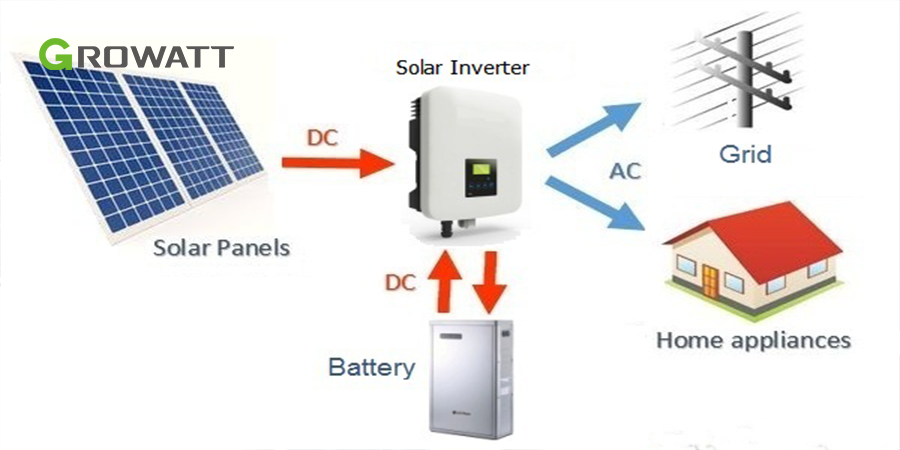A solar inverter, also known as a photovoltaic (PV) inverter, is an essential component of a solar power system. Its primary function is to convert the direct current (DC) electricity generated by solar panels into alternating current (AC) electricity that can be used to power household appliances and fed into the electrical grid.
Here’s how a solar inverter works:
- Conversion: When sunlight strikes solar panels, DC power is produced—however, most home equipment and the power grid run on AC electricity. The solar inverter transforms DC power generated by the solar panels into AC electricity.
- Synchronization: The inverter synchronizes the utility grid’s current AC energy supply with the AC electricity produced by the solar panels. This synchronization makes it possible to use solar energy in combination with grid electricity or to feed any extra energy back into the grid.
- Maximum Power Point Tracking (MPPT): MPPT technology, which maximizes the solar system’s efficiency, is frequently included in solar inverters. To guarantee that the solar panels produce their maximum power, MPPT continuously modifies the voltage and current output, even under varying conditions like shading or temperature changes.
- Monitoring: Many modern solar inverters come with monitoring capabilities. They provide real-time data on the solar system’s performance, including the amount of electricity being generated, energy production trends, and potential issues or faults. This information helps users monitor their solar system’s performance and identify maintenance or troubleshooting needs.
In short, a solar inverter plays an important role in converting DC electricity produced by solar panels into AC electricity that can be used to power homes and businesses or feed excess energy into the grid.
To buy or even how to operate Growatt off grid inverters , you can visit our site or contact the contact numbers available on the site.
Different components of a solar panel
A solar panel comprises some essential parts that operate in concert to collect sunlight and transform it into useful power. The primary elements of a conventional solar panel are listed below:
- Photovoltaic (PV) Cells: A solar panel comprises them. When exposed to sunlight, PV cells comprised of semiconductor materials, commonly silicon, produce an electric current. They have layers of materials that are both positively and negatively charged, which produces an electric field.
- Encapsulant: The encapsulant covers the PV cells’ front and rear surfaces. Either EVA or materials comparable to it are often used to make it. The cells are shielded and assisted in maintaining long-term function and endurance by the encapsulant.
- Glass Cover: A rigid, tempered glass sheet protects the front side of a solar panel. This glass lets sunlight flow through while shielding the PV cells from outside factors, including dust, moisture, and collisions.
- Backsheet: The backsheet is a shield that covers the solar panel’s back. It is often constructed of a polymer substance that serves as a moisture barrier and improves the panel’s overall longevity.
- Frame: Solar panels have an aluminum frame around their edges to provide structural support and stiffness. The panel installation uses the frame as a mounting point as well.
- Junction Box: The junction box is on the back of the solar panel. It contains electrical connections and wiring that allow the individual PV cells within the panel to be connected in a series or parallel configuration. The junction box also includes bypass diodes to optimize the panel’s performance by minimizing losses due to shading or cell malfunctions.
- Busbars and Conductive Ribbons: Busbars are thin metal strips that collect the electrical current generated by the PV cells. They are usually made of copper or silver. Conductive ribbons interconnect the individual PV cells within a panel and transfer the electrical current between them.
- Anti-Reflective Coating: Some solar panels have an anti-reflective coating applied to the front glass surface. This coating helps to reduce reflection and increase light absorption, maximizing the panel’s efficiency.
These components harness sunlight, convert it into electricity, and deliver it for various applications, from powering homes and businesses to charging batteries or supplying electricity to the grid.
What is the difference between a power inverter and a solar inverter?
power inverter:
Direct current (DC) is changed into alternating current (AC) using a power inverter. It is frequently used to transform DC power from batteries or other DC power sources into AC electricity that may power domestic appliances, electronic gadgets, or industrial machinery.
In instances where AC power is not easily accessible or in off-grid applications, power inverters are routinely employed.
Solar Inverter:
Also referred to as a photovoltaic (PV) inverter, a solar inverter is made expressly used with solar panels. It transforms the DC electricity produced by solar panels into AC power that may be used in residences and commercial buildings or returned to the power grid.
Grid-tied solar PV systems linked to the utility grid require solar inverters as a crucial component. They guarantee effective power conversion and utility grid synchronization.
In conclusion, while power inverters and solar inverters convert electricity, power inverters are more versatile. They can transform DC power from a variety of sources into AC power.
In contrast, solar inverters are specifically created to transform DC power generated by solar panels into usable AC power for residential, commercial, or grid-connected applications.
What are the disadvantages of a solar inverter?
- It costs a lot to purchase inverters of this type. Sunlight is required to produce enough power.
- Installation takes a sizable amount of room.
- A battery is needed to supply the home, business, etc., with adequate energy at night.
Can solar inverters run without electricity?
Yes, it can if the inverter is connected directly to the solar panels and the grid for backup power.
The best collection for buying a solar inverter
To buy growatt inverter in Dubai, visit our site or consult an expert in this field who can help you find a suitable one for your needs and budget.




